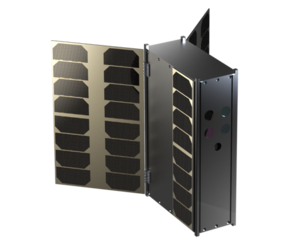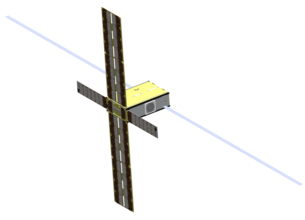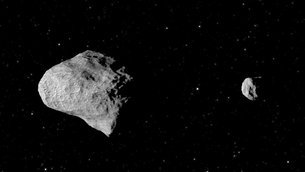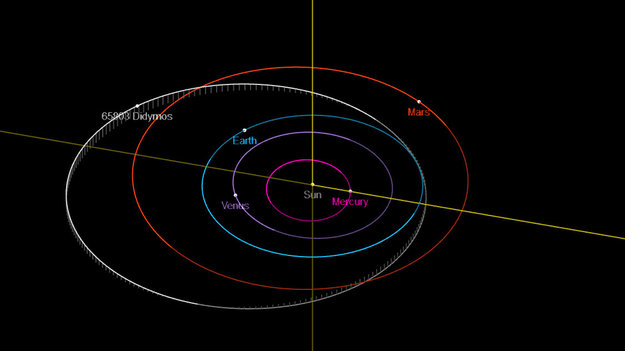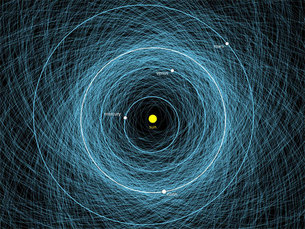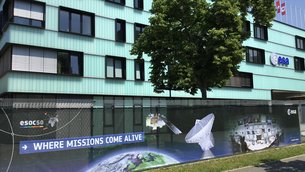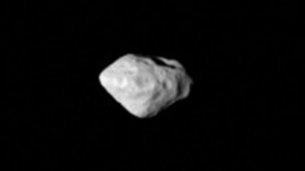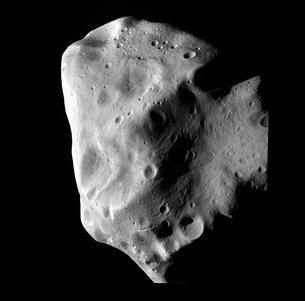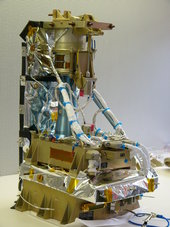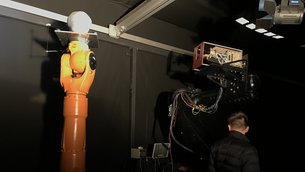9.01.2019

CUBESATS JOINING HERA MISSION TO ASTEROID SYSTEM
When ESA’s planned Hera mission journeys to its target binary asteroid system, it will not be alone. The spacecraft will carry two tiny CubeSats for deployment around – and eventual landing on – the Didymos asteroids. Each companion spacecraft will be small enough to fit inside a briefcase, as compared to the desk-sized Hera.
CubeSats are nanosatellites based on standardised 10 cm-sized units. Hera has room to deliver two ‘six-unit’ CubeSat missions to the Didymos asteroid system – a 780 m-diameter mountain-sized main body is orbited by a 160 m moon, informally called ‘Didymoon’, about the same size as the Great Pyramid of Giza.
The Hera mission received proposals for CubeSats from across Europe, and an evaluation board has now made the final selection.
“We’re very happy to have these high-quality CubeSat missions join us to perform additional bonus science alongside their Hera mothership,” explains Hera manager Ian Carnelli.
“Carrying added instruments and venturing much closer to our target bodies, they will give different perspectives and complementary investigations on this exotic binary asteroid. They will also give us valuable experience of close proximity operations relayed by the Hera mothercraft in extreme low-gravity conditions. This will be very valuable to many future missions.”
Paolo Martino, Hera spacecraft lead engineer, adds: “The idea of building CubeSats for deep space is relatively new, but was recently validated by NASA’s InSight landing on Mars last November, when a pair of accompanying CubeSats succeeded in relaying the lander’s radio signals back to Earth – as well as returning imagery of the Red Planet.”
The first CubeSat companion is called the Asteroid Prospection Explorer (or ‘APEX’), and was developed by a Swedish/Finnish/Czech/German consortium. It will perform detailed spectral measurements of both asteroids’ surfaces – measuring the sunlight reflected by Didymos and breaking down its various colours to discover how these asteroids have interacted with the space environment, pinpointing any differences in composition between the two. In addition, APEX will make magnetic readings that will give insight into their interior structure of these bodies.
Guided by a navigation camera and a ‘laser radar’ (lidar) instrument, APEX will also make a landing on one of the asteroids, gathering valuable data in the process using inertial sensors, and going on to perform close-up observations of the asteroid’s surface material.
The other CubeSat is called Juventas, developed by Danish company GomSpace and GMV in Romania, and will measure the gravity field as well as the internal structure of the smaller of the two Didymos asteroids.
In close orbit around Didymoon, Juventas will line up with Hera to perform satellite-to-satellite radio-science experiments and carry out a low-frequency radar survey of the asteroid interior, similar to performing a detailed ‘X-ray scan’ of Didymoon to unveil its interior. The adventure will end with a landing, using the dynamics of any likely bouncing to capture details of the asteroid’s surface material – followed by several days of surface operations.
Hera is set to be humankind’s first mission to a binary asteroid system. As well as testing technologies in deep space and gathering crucial science data, Hera is designed to be Europe’s contribution to an international planetary defence effort: it would survey the crater and measure orbital deviation of Didymoon caused by the earlier collision of a NASA probe, called DART. This unique experiment will validate the asteroid deflection technique referred to as kinetic impactor, enabling humankind to protect our planet from asteroid impacts.

Next, the two CubeSats will have their designs refined and interfaces with their mothership finalised, in line with continuing design work on the Hera mission itself, which will be presented to ESA’s Space19+ meeting towards the end of this year, where Europe’s space ministers will take a final decision on flying the mission.

CLOSE ENCOUNTERS: PLANNING FOR EXTRA HERA FLYBY
ESA’s proposed Hera mission will already visit two asteroids: the Didymos binary pair. The Hera team hopes to boost that number by performing a flyby of another asteroid during the mission’s three-year flight.
The opportunity arises because Hera will be flying out to match Didymos’ 770-day orbit, which circles from less than 10 million km from Earth to out beyond Mars, at more than double Earth’s distance from the Sun.
In the process Hera will pass both multiple near-Earth asteroids and the inner edge of the main Asteroid Belt. Initial studies at ESA’s European Space Operations Centre have turned up dozens of candidate asteroids across different mission scenarios.
“Ideally we would like a flyby of another binary asteroid, to enable comparisons with Didymos,” explains ESA’s Hera project scientist, Michael Küppers.
“We would choose something of a different taxonomic type from the S-type asteroids like Didymos. We would also prefer a larger object: its greater size would allow us to resolve it meaningfully from further away.”
Take as an example one body researchers would like to see: the 2121 Sevastopol binary pair in the inner belt has an 8.6 km diameter main body with a 3.5 km diameter moon.
This system is a member of the poorly understood ‘Flora’ family of main belt stony asteroids, produced by a collision event a relatively recent 100 million years ago – theorised to be associated with the Chicxulub impact that killed the dinosaurs.
The next step would be to create a shortlist of targets, which could then be the subject of ground-based observations to determine more about their properties and sharpen knowledge of their orbits before Hera’s launch in late 2023.
ESA’s Rosetta comet-chaser performed two asteroid flybys as it passed through the main belt during its decade-long flight to comet 67P/Churyumov–Gerasimenko, passing the 5-km diameter diamond-shaped 2867 Šteins and the mammoth 120-km diameter 21 Lutetia.
“To make flybys happen, we have to know where our trajectory will pass relatively close to asteroids if we do nothing,” notes Michael Khan, heading Mission Analysis at ESA’s Flight Dynamics division. “Then we tweak the trajectory to make a specific difference to that distance, bringing us much closer.
“With Rosetta we had a lot of capability, because it was a large spacecraft with extra fuel in in the tanks to get the mission back on track in case something went wrong. Plus we were performing lots of gravity-assist flybys around Earth and Mars, and massaging those flybys slightly gave us a lot of freedom to manoeuvre.
“Hera is not Rosetta, however: this will be a smaller mission with a shorter cruise phase and lower performance limits. We will still try, but the constraints are such that we won’t know for certain which asteroids we could target until after Hera’s launch. It will come down to what day within Hera’s launch window that we take off, and also the precision of that take-off – it is possible that any extra fuel earmarked for asteroid flybys might be needed to fine-tune our trajectory to Didymos. But any flyby would be an excellent opportunity to boost Hera's science return even further.””
To compare the two missions, Rosetta was lorry-sized, while Hera will be the scale of a desk. But any asteroid flyby would benefit its end mission as well as offering plentiful bonus science.
Michael Küppers was also part of the Rosetta team: “These hours-long asteroid flybys were quite dramatic events, and our opportunity to try out our scientific instruments and obtain scientific results from these unknown objects, preparing for our main goal of 67P/Churyumov–Gerasimenko.”
Hera’s lead scientist Patrick Michel, CNRS Director of Research of France’s Côte d'Azur Observatory, hopes Hera would indeed achieve a flyby: “Any object would be valuable. Each time we’ve encountered a new asteroid we’ve discovered something unexpected.”
Hera, Europe’s contribution to an international planetary defence experiment, is currently under study to be presented for approval by ESA’s Space19+ Council meeting of European space ministers.

SELF-DRIVING SPACECRAFT SET FOR PLANETARY DEFENCE EXPEDITION
Engineers designing ESA’s Hera planetary defence mission to the Didymos asteroid pair are developing advanced technology to let the spacecraft steer itself through space, taking a similar approach to self-driving cars.
“If you think self-driving cars are the future on Earth, then Hera is the pioneer of autonomy in deep space,” explains Paolo Martino, lead systems engineer of ESA's proposed Hera mission. “While the mission is designed to be fully operated manually from ground, the new technology will be tested once the core mission objectives are achieved and higher risks can be taken.”
Hera is currently the subject of detailed design work, ahead of being presented to Europe’s space ministers at the Space19+ Ministerial Council this November. The spacecraft will survey a tiny 160-m diameter moon of the 780-m diameter Didymos asteroid, in the aftermath of a pioneering planetary defence experiment.
“The spacecraft will operate like an autonomous vehicle, fusing data from different sensors to build up a coherent model of its surroundings,” says ESA guidance, navigation and control (GNC) engineer Jesus Gil Fernandez.
“Hera’s most crucial data source will be its Asteroid Framing Camera, combined with inputs from a star-tracker, laser altimeter, thermal infrared camera plus inertial sensors including accelerometers.”
The resulting autonomy should let Hera navigate safely as close at 200 metres from the surface of the smaller asteroid ‘Didymoon’, enabling the acquisition of high-resolution scientific observations down to 2 cm per pixel – focused in particular on the impact crater left by the US DART spacecraft crashing into Didymoon to divert its orbit.
GNC engineer Massimo Casasco adds: “All other deep-space missions, by comparison, have had a definite driver back on Earth, with navigation commands planned at mission control in ESA’s European Space Operations Centre, before being uplinked to the spacecraft hours later. During Hera’s experimental phase, equivalent decisions will be performed aboard on an autonomous basis in real time.”
For maximum navigation reliability, Hera’s main onboard computer will be complemented by a dedicated image processing unit – in the same way desktop PCs often have separate graphics cards – while borrowing machine vision techniques from industrial cameras employed on production lines.
Image-based navigation
Due for launch in October 2023 and reaching its target Didymos near-Earth asteroids three years later, ESA’s proposed Hera mission will navigate itself in three different modes. On initial approach the main asteroid will appear as one more bright star among many.
“From afar, it will be only a tiny dot,” explains Jesus. “We would have to take several pictures to observe its motion against the background starfield.”
This imaging technique is similar to those developed to detect small items of space debris and to eventually permit future robotic debris-removal missions to rendezvous with them.
The next mode will be the dominant one for the bulk of Hera’s mission between 30 km to 8 km distance, with the larger ‘Didymain’ asteroid framed in its camera view as an overall reference point.
“This mode depends on having the big asteroid smaller than our overall camera field of view, and detecting the contrast of its edges giving way to the space beyond,” says Massimo. “We take advantage of its roughly-spherical shape to fit it within a circle and estimate the line-of-sight distance between the spacecraft and the asteroid ‘centroid’.”
Didymain has been selected as the navigation reference point as it is the body where most of the system’s gravity is concentrated, and much more is known about it than the smaller Didymoon.
This method will become unworkable however once Hera comes closer than 8 km from Didymain, and the asteroid fills its field of view. Then comes the most ambitious navigation mode of all, based on autonomous feature tracking with no absolute reference.
Jesus explains: “This will be a matter of imaging the same features – such as boulders and craters – in different pictures to gain a sense of how we’re moving with respect to the surface, combined in turn with other information including onboard accelerometers for dead reckoning and the thermal infrared camera for overflying the asteroid’s night side.”
Feature tracking will also be used to measure the mass of Didymoon, by measuring the ‘wobble’ it causes its parent, relative to the common centre of gravity of the overall binary Didymos system. This will be achieved by identifying small metre-scale variations in the rotation of fixed landmarks around this centre of gravity over time.
In practice, there will undoubtedly be surprises, observes Massimo: “A flatter surface would be worse than something with a lot of boulders with high contrast, making it easier to unambiguously identify features. Plus a less spherical body with lots of irregular shapes and shadows would be more of a challenge for the kind of edge detection we’re employing.”
Europe-wide development team
GMV in Spain is leading development of this vision-based navigation system, supported by OHB in Sweden with other partners including GMV in Poland and Romania. A replica of the Asteroid Framing Camera Hera will rely on is currently being used for practical testing of the software together with a high-resolution model of Didymos.
This technology will have wider uses in many other missions, including ESA’s planned Space Servicing Vehicle for refurbishing satellites and removing space debris, as well as the ambitious Mars Sample Return mission, the homeward leg of which will involve autonomous rendezvous in Mars orbit. Ultimately, once proven, this technology would be an enabling building block for low-cost planetary probes into deep space.


